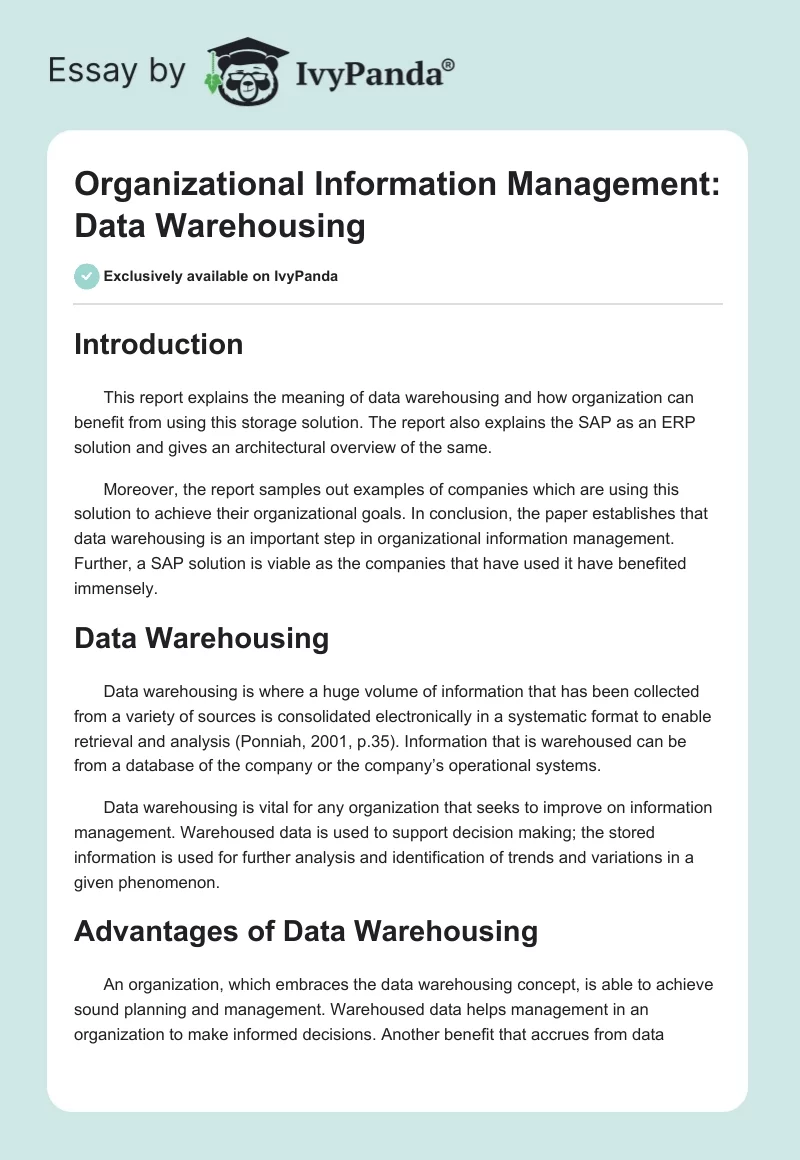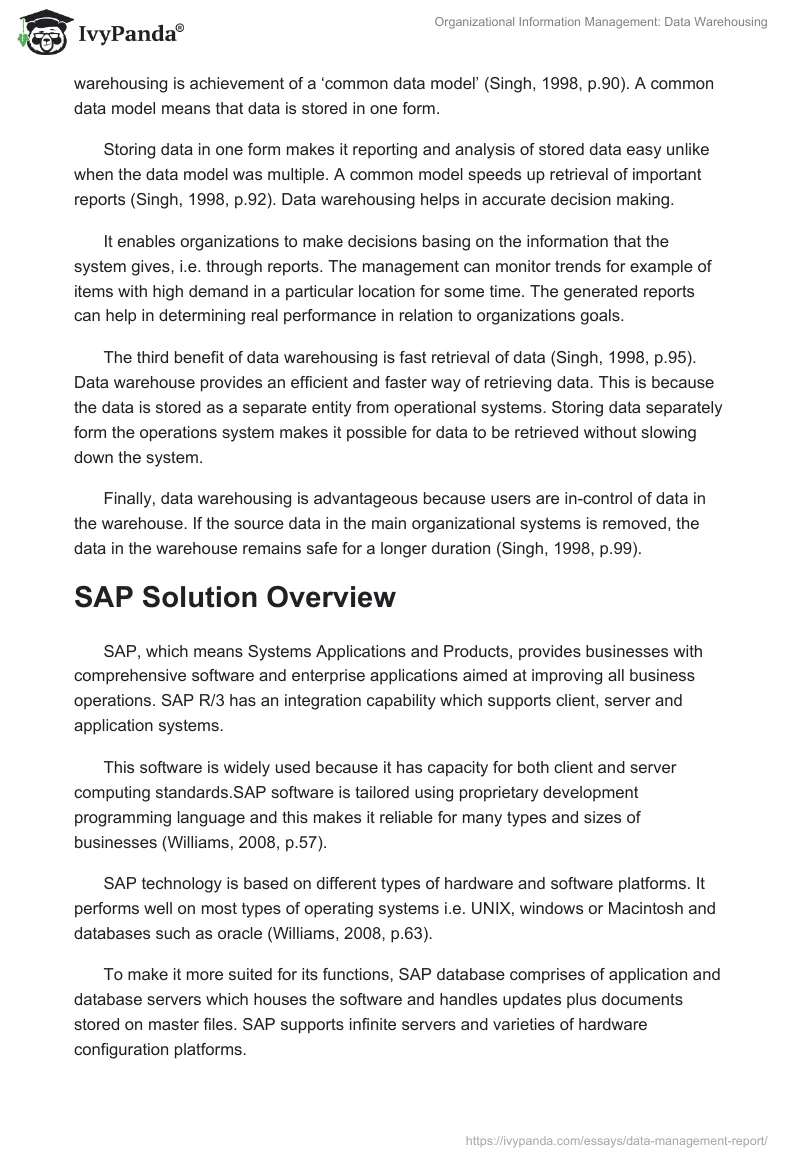Introduction
This report explains the meaning of data warehousing and how organization can benefit from using this storage solution. The report also explains the SAP as an ERP solution and gives an architectural overview of the same.
Moreover, the report samples out examples of companies which are using this solution to achieve their organizational goals. In conclusion, the paper establishes that data warehousing is an important step in organizational information management. Further, a SAP solution is viable as the companies that have used it have benefited immensely.
Data Warehousing
Data warehousing is where a huge volume of information that has been collected from a variety of sources is consolidated electronically in a systematic format to enable retrieval and analysis (Ponniah, 2001, p.35). Information that is warehoused can be from a database of the company or the company’s operational systems.
Data warehousing is vital for any organization that seeks to improve on information management. Warehoused data is used to support decision making; the stored information is used for further analysis and identification of trends and variations in a given phenomenon.
Advantages of Data Warehousing
An organization, which embraces the data warehousing concept, is able to achieve sound planning and management. Warehoused data helps management in an organization to make informed decisions. Another benefit that accrues from data warehousing is achievement of a ‘common data model’ (Singh, 1998, p.90). A common data model means that data is stored in one form.
Storing data in one form makes it reporting and analysis of stored data easy unlike when the data model was multiple. A common model speeds up retrieval of important reports (Singh, 1998, p.92). Data warehousing helps in accurate decision making.
It enables organizations to make decisions basing on the information that the system gives, i.e. through reports. The management can monitor trends for example of items with high demand in a particular location for some time. The generated reports can help in determining real performance in relation to organizations goals.
The third benefit of data warehousing is fast retrieval of data (Singh, 1998, p.95). Data warehouse provides an efficient and faster way of retrieving data. This is because the data is stored as a separate entity from operational systems. Storing data separately form the operations system makes it possible for data to be retrieved without slowing down the system.
Finally, data warehousing is advantageous because users are in-control of data in the warehouse. If the source data in the main organizational systems is removed, the data in the warehouse remains safe for a longer duration (Singh, 1998, p.99).
SAP Solution Overview
SAP, which means Systems Applications and Products, provides businesses with comprehensive software and enterprise applications aimed at improving all business operations. SAP R/3 has an integration capability which supports client, server and application systems.
This software is widely used because it has capacity for both client and server computing standards.SAP software is tailored using proprietary development programming language and this makes it reliable for many types and sizes of businesses (Williams, 2008, p.57).
SAP technology is based on different types of hardware and software platforms. It performs well on most types of operating systems i.e. UNIX, windows or Macintosh and databases such as oracle (Williams, 2008, p.63).
To make it more suited for its functions, SAP database comprises of application and database servers which houses the software and handles updates plus documents stored on master files. SAP supports infinite servers and varieties of hardware configuration platforms.
ERP Overview
ERP is an industry solution which allows business to integrate their services to conform to the pace of modern technology and business transaction requirements. ERP, which means Enterprise Resource Planning, is an integrated solution that is used to manage all aspect of business function in an organization (O’Brien, 2004, p.86).
The ERP makes this possible because of its modular programs which are linked to facilitate coordination. These links facilitate sharing of information and enhance communication between different departments within an organization. ERP allows organizations to have centralized information in real time facilitating fast decision making.
One of the reasons for implementation of ERP is difficulty in information dissemination because of differences in computer platforms within an organization (O’Brien, 2004, p.93). Some organizations have different standards of operating systems and hardware profiles, which poses a challenge in implementing a standard architecture for the ERP.
Secondly, ERP systems are implemented because a single integrated system helps reduce time consumed thus increasing productivity in an organization (Larocca, 1999, p.80). The third reason why organizations choose to implement an ERP system is that it helps to improve in customer satisfaction by reducing time delivery and increasing quality in regard to type of transaction.
It ensures fast accessibility and enables accuracy in retrieval (Larocca, 1999, p.86). The fifth reason for implementation of an ERP system is to have a better business framework e.g. an improved framework for monitoring transactions such as sales and inventories. This helps businesses to institute clear planning, tracking and enhances future forecasting for the business (Larocca, 1999, p.89).
Sample Company Profiles
The John Hopkins Hospital
The John Hopkins Hospital is a healthcare industry located in Baltimore, Maryland. The hospital had a number of challenges before adopting SAP solution. They had a single printing platform and delay was an issue and sometimes documents got lost. John Hopkins wanted a system which could easily integrate with other business application such as finance and in addition a solution to manage patient processes.
Moreover, John Hopkins wanted a solution which would support high speed printing volume and SAP was viewed to posses all this. The solution has brought a lot of benefit to the Hospital. For example, printing is now efficiently managed on a single platform. Many other applications have been integrated with the SAP solution and it is simple to format and add printers to network because of standard platform.
The implementation of the project took one month. Afterwards, the billing and business application program to register patients was added. There has been ongoing support since implementation to facilitate solution efficiency
Procter and Gamble
Procter and Gamble is a consumer goods company located in Cincinnati, Ohio. The company had challenges in their old system. They wanted a solution which would improve productivity for their staff members who were involved in sales and related processes. They wanted to customize cockpit so that they can resolve sales order issues.
In order to realize this, there were no other solution that could help and the SAP solution came in handy. The SAP has enabled the company to improve user efficiency and productivity, which has been made possible by integrating scattered functions in a single cockpit.
It has also helped to reduce the cost of tailor made development. Implementation was done by a team and was completed in 10 months. The solution was piloted to assess its effectiveness shortly after it was implemented and later full implementation followed
Basell Polyolefin’s
It is the world’s largest producer of polypropylene products. It is based in the Netherlands. Prior to adopting the SAP solution, the company had faced challenges of replacing their batch system with real time solutions. The batch system was slow, costly and time consuming. They didn’t want to disrupt the business by introducing other solutions so care was considered in choosing the right solution for the company.
They required a solution that would help to increase and improve the efficiency of all processes and utilize the benefit of IT resources and its infrastructure. Upon SAP’s implementation, the company is enjoying more efficient and fast processing of its transaction. There is good utilization of IT resources and there has been reduction in costs of integration with other software’s. The implementation took three day and it was simple to configure.
Conclusion
For better coordination, planning and control of business in an organization, information management is crucial. Data warehousing helps in storing information in a way that it can easily be accessed and retrieved. This is important because stored information is crucial for business forecasting. Most organizations, in response to the changing business environment, are adopting ERP solutions.
An ERP solution helps integrate operations and systems in organizations facilitating faster transactions. One such ERP solution is SAP. From the different companies that have adopted SAP, it is clear that it is efficient and effective software that meets many organizational needs. However, when it comes to IT solutions, each organization has to evaluate its own characteristics before sourcing for software.
References
Larocca, D., 1999, Sams Teach Yourself SAP R/3 in 24 hours, Sams, Indiana
O’Brien, J., A., 2004, Management Information Systems: Managing Information Technology in the Business Enterprise, McGraw-Hill/Irwin, New York
Singh, H., 1998, Data Warehousing: Concepts, Technologies, Implementations, and Management, Prentice Hall PTR, New Jersey
Ponniah, P., 2001, Data Warehousing Fundamentals: a Comprehensive Guide for IT Professionals, John Wiley and Sons, New York
Williams, G., C., 2008, Implementing SAP ERP Sales & Distribution, McGraw-Hill, New York


